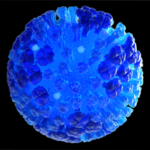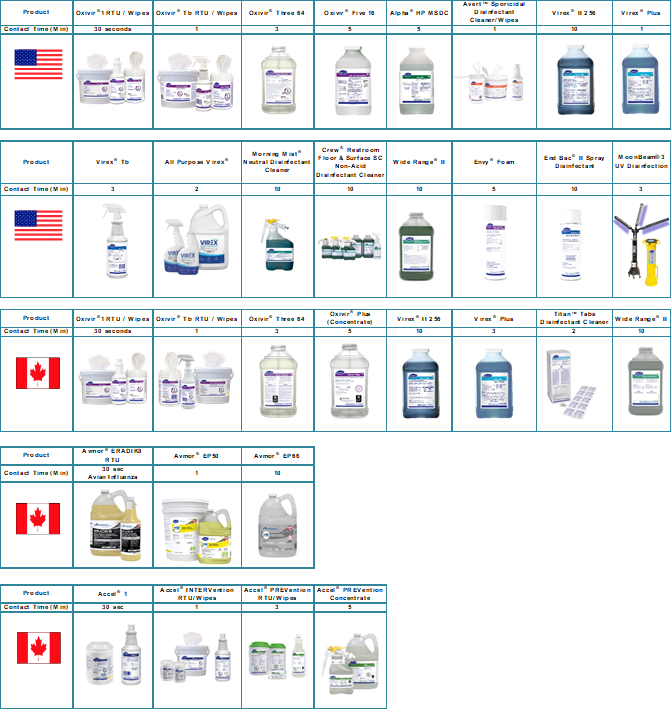
General Information
Influenza (the flu) is a contagious respiratory illness caused by influenza viruses. It can cause mild to severe illness and may lead to death. Older people, young children, and people with certain comorbidities, such as asthma, diabetes, heart or kidney diseases, are at high risk for serious complications.
The influenza virus can infect many different species including ducks, chickens, pigs, horses, whales, and seals. Animals, like pigs, can also be infected by human and bird influenza viruses, which can lead to genetic mixing. Most animal flu viruses will not infect humans, this is a rare occurrence. For more information on avian influenza, see Diversey’s separate Avian Influenza CleanPath.
Human influenza has many different “strains,” which are named in a series of letters and numbers that reflect their viral composition (e.g., H5N1). Influenza strains can circulate at different times and seasons and in many different places simultaneously.
Symptoms
In the English language, the word “flu” is often used to describe a wide variety of illnesses and symptoms, but true influenza (confirmed by laboratory testing) is a specific diagnosis. A primary differentiating characteristic of seasonal influenza is its “sudden onset,” meaning symptoms develop very quickly.
Symptoms can include fever or feeling feverish/chills, cough, sore throat, runny or stuffy nose, muscle or body aches, headaches, and fatigue. Vomiting and diarrhea may occur in some cases, though this is more common in children than adults.
Symptoms start 1 to 4 days after the virus enters the body. That means that you may be able to pass on the flu to someone else before you know you are sick, as well as while you are sick for up to 7 days. Some people can be infected with the flu virus but have no symptoms. During this time, those persons may still spread the virus to others.
Transmission
Most experts think that flu viruses are spread mainly by droplets made when people with the flu cough, sneeze or talk. People with the flu can spread it to others up to 6 feet away. These droplets can land in the mouth, nose or eyes of people who are nearby or possibly be inhaled into the lungs. Less often, a person might also get flu by touching a surface or object that has the flu virus on it and then touching his/her own mouth or nose.
Most healthy adults may be able to infect others beginning 1 day before symptoms develop and up to 5 to 7 days after becoming sick. Children and people with weakened immune systems may pass the virus for more than 7 days after becoming sick.
Prevention
Annual vaccination is key to preventing influenza transmission. Influenza vaccination also helps to reduce flu-related illnesses, severity of symptoms and can even lessen the risk of serious complications that can result in hospitalization or even death.
Public health recommendations also include everyday preventive actions such as staying away from people who are sick (also known as “distancing”), covering coughs and sneezes, frequent handwashing, and taking steps for cleaner air to help slow the spread of germs that cause respiratory (nose, throat, and lungs) illnesses like flu.
Vaccination
Getting a flu vaccine can protect against flu viruses that are the same or related to the viruses in the vaccine. The vaccine is not a live virus. Different strains of influenza A (H1N1), A (H3N2), and one or two influenza B viruses are included in each year’s influenza vaccine, depending on the vaccine. Flu vaccines will NOT protect against infection and illness caused by other viruses that can also cause influenza-like symptoms, such as Rhinovirus, RSV or parainfluenza.
For more information on influenza vaccination, please visit CDC’s https://www.cdc.gov/flu/vaccines/index.html or Health Canada’s Flu (influenza): Get your flu vaccine (flu shot) – Canada.ca.
Treatment
If diagnosed with seasonal influenza, healthcare providers may prescribe antiviral medication. Antiviral drugs work best when started early, such as one to two days after your flu symptoms begin and can help lessen influenza symptoms.
Cleaning and Disinfection
Diligent and frequent cleaning and disinfection of environmental surfaces is a core strategy for the prevention and control of all infections. Influenza is an enveloped virus, meaning it is relatively easy to inactivate with EPA or DIN registered disinfectants.
The EPA & Health Canada have established that if a disinfectant carries an influenza claim, it will allow companies to promote their product as effective against all strains of influenza. Disinfectants have not shown strain specificity. Thus, there is no value in testing against a number of additional strains beyond common influenza strains. In the US, there is no specific list of EPA products registered with specific claims against seasonal influenza.
Influenza is susceptible to the following Diversey disinfectants:

References:
Influenza (Flu) | Influenza (Flu) | CDC
Treating Flu with Antiviral Drugs | Influenza (Flu) | CDC
Influenza (Flu) | Influenza (Flu) | CDC
Flu (influenza): Get your flu vaccine (flu shot) – Canada.ca
Reviewed/Revised February 2025

